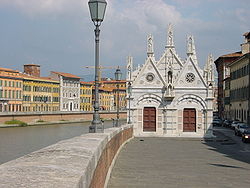
Santa Maria della Spina
Encyclopedia

Gothic architecture
Gothic architecture is a style of architecture that flourished during the high and late medieval period. It evolved from Romanesque architecture and was succeeded by Renaissance architecture....
church in the Italian
Italy
Italy , officially the Italian Republic languages]] under the European Charter for Regional or Minority Languages. In each of these, Italy's official name is as follows:;;;;;;;;), is a unitary parliamentary republic in South-Central Europe. To the north it borders France, Switzerland, Austria and...
city of Pisa
Pisa
Pisa is a city in Tuscany, Central Italy, on the right bank of the mouth of the River Arno on the Tyrrhenian Sea. It is the capital city of the Province of Pisa...
. The church, erected in 1230, was originally known as Santa Maria di Pontenovo: the new name of Spina ("thorn") derives from the presence of a thorn allegedly part of the crown dressed by Christ on the Cross, brought here in 1333. In 1871 the church was dismantled and rebuilt on a higher level due to dangerous inflitration of water from the Arno river: the church was slightly altered in the process, however.
Exterior
The church is one of the most outstanding GothicGothic architecture
Gothic architecture is a style of architecture that flourished during the high and late medieval period. It evolved from Romanesque architecture and was succeeded by Renaissance architecture....
edifices of Europe
Europe
Europe is, by convention, one of the world's seven continents. Comprising the westernmost peninsula of Eurasia, Europe is generally 'divided' from Asia to its east by the watershed divides of the Ural and Caucasus Mountains, the Ural River, the Caspian and Black Seas, and the waterways connecting...
: it has a rectangular plant, with an external facing wholly composed of marble, laid in polychrome bands. The exterior appearance is marked by cusp
Cusp
Cusp may refer to:*Beach cusps, a pointed and regular arc pattern of the shoreline at the beach*Behavioral cusp an important behavior change with far reaching consequences*Cusp catastrophe...
s, tympani
Pediment
A pediment is a classical architectural element consisting of the triangular section found above the horizontal structure , typically supported by columns. The gable end of the pediment is surrounded by the cornice moulding...
and tabernacles
Church tabernacle
A tabernacle is the fixed, locked box in which, in some Christian churches, the Eucharist is "reserved" . A less obvious container, set into the wall, is called an aumbry....
, together with a complicated sculpture decoration with tarsiae, rose-windows and numerous statues from the main Pisane artists of the 14th century. These include Lupo di Francesco, Andrea Pisano
Andrea Pisano
Andrea Pisano , also known as Andrea da Pontedera, was an Italian sculptor and architect.-Biography:Andrea Pisano was born at Pontedera, where he also died....
with his sons Nino
Nino Pisano
thumb|280px|"Euclid", panel from [[Giotto's Bell Tower]], now in the [[Museo dell'Opera del Duomo |Museo dell'Opera del Duomo]], [[Florence]].Nino Pisano thumb|280px|"Euclid", panel from [[Giotto's Bell Tower]], now in the [[Museo dell'Opera del Duomo (Florence)|Museo dell'Opera del Duomo]],...
and Tommaso, and Giovanni di Balduccio
Giovanni di Balduccio
Giovanni di Balduccio was an Italian sculptor of the Medieval period. He was born in Pisa, and likely did not train directly with the famous Pisan sculptor Andrea Pisano. He travelled to Milan to help sculpt the arc of St. Peter Martyr now in the Portinari Chapel, in the Basilica of...
.
The façade has two gates with lintelled archs. Among these lies the tabernacle with the statues of Madonna with the Child and two Angels, attributed to Giovanni Pisano. Two niches open in the upper part of the façade: these houses the statue of Christ among the two Annunciation ones, and two other angels.
The right side has also a rich decoration with cusps and thirteen statues of the Apostles and Christ, from Lupo's workshop. The small sculptures portraying Saints and Angels over the tympani are from Nino Pisano's workshop, while the niche in the right pillar has a Madonna with Child by Giovanni di Balduccio.
The back side has three round archs with simple windows. The tympani are decorated with the Evangelists' symbols, intervalled by niches with the statues of the Saints Peter, Paul and John the Baptist. The high pyramid-like spires end with the statues of the Madonna with Child between two angels, by Nino Pisano.
Interior
If compared to the rich exterior, the interior appears quite simple. It has a single room, with a ceiling painted during the 19th century reconstruction. In the presbytery's centre is one of the highest masterpieces of GothicGothic art
Gothic art was a Medieval art movement that developed in France out of Romanesque art in the mid-12th century, led by the concurrent development of Gothic architecture. It spread to all of Western Europe, but took over art more completely north of the Alps, never quite effacing more classical...
sculpture, the Madonna of the Rose by Andrea and Nino Pisano. On the left wall is the tabernacle in which once was the crown's relic, by Stagio Stagi (1534). Another statue by the Pisanos, the Madonna del Latte, was once here, but has been moved to the city's St. Matthew Museum.

